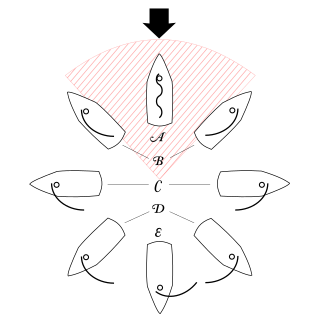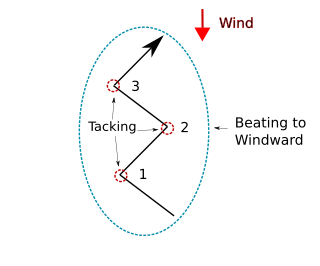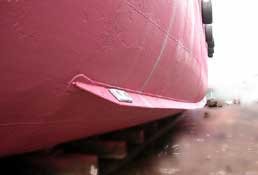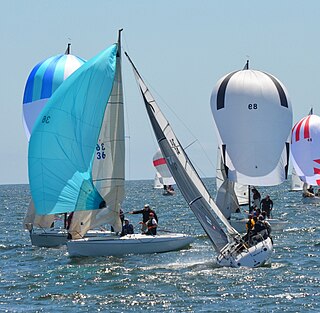
Sailing employs the wind—acting on sails, wingsails or kites—to propel a craft on the surface of the water, on ice (iceboat) or on land over a chosen course, which is often part of a larger plan of navigation.
A skeg is a sternward extension of the keel of boats and ships which have a rudder mounted on the centre line. The term also applies to the lowest point on an outboard motor or the outdrive of an inboard/outboard. In more recent years, the name has been used for a fin on a surfboard which improves directional stability and to a movable fin on a kayak which adjusts the boat's centre of lateral resistance. The term is also often used for the fin on water skis in the U.S. It has been used for the vertical fin on seaplane hulls and floats. The wear-bar on the bottom of snowmobile ski may also be called a skeg.
The weather gage is the advantageous position of a fighting sailing vessel relative to another. It is also known as "nautical gauge" as it is related to the sea shore. The concept is from the Age of Sail and is now antique. A ship at sea is said to possess the weather gage if it is in any position upwind of the other vessel. Proximity with the land, tidal and stream effects and wind variability due to geography may also come into play.

A point of sail is a sailing craft's direction of travel under sail in relation to the true wind direction over the surface.

A jibe (US) or gybe (Britain) is a sailing maneuver whereby a sailing vessel reaching downwind turns its stern through the wind, which then exerts its force from the opposite side of the vessel. Because the mainsail boom can swing across the cockpit quickly, jibes are potentially dangerous to person and rigging compared to tacking. Therefore, accidental jibes are to be avoided while the proper technique must be applied so as to control the maneuver. For square-rigged ships, this maneuver is called wearing ship.

A daggerboard is a retractable centreboard used by various sailing craft. While other types of centreboard may pivot to retract, a daggerboard slides in a casing. The shape of the daggerboard converts the forward motion into a windward lift, countering the leeward push of the sail. The theoretical centre of lateral resistance is on the trailing edge of the daggerboard.

Tacking or coming about is a sailing maneuver by which a sailing craft, whose next destination is into the wind, turns its bow toward and through the wind so that the direction from which the wind blows changes from one side of the boat to the other, allowing progress in the desired direction. Sailing vessels are unable to sail higher than a certain angle towards the wind, so "beating to windward" in a zig-zag fashion with a series of tacking maneuvers, allows a vessel to sail towards a destination that is closer to the wind that the vessel can sail directly.

The winged keel is a sailboat keel layout first fitted on the 12-metre class yacht Australia II, 1983 America's Cup winner.

"Man overboard!" is an exclamation given aboard a vessel to indicate that a member of the crew or a passenger has fallen off of the ship into the water and is in need of immediate rescue. Whoever sees the person fall is to shout, "Man overboard!" and the call is then to be reported once by every crewman within earshot, even if they have not seen the victim fall, until everyone on deck has heard and given the same call. This ensures that all other crewmen have been alerted to the situation and notifies the officers of the need to act immediately to save the victim. Pointing continuously at the victim may aid the helmsman in approaching the victim.

Model yachting is the pastime of building and racing model yachts. It has always been customary for ship-builders to make a miniature model of the vessel under construction, which is in every respect a copy of the original on a small scale, whether steamship or sailing ship. There are fine collections to be seen at both general interest museums such as the Victoria and Albert Museum in London and at many specialized maritime museums worldwide. Many of these models are of exquisite workmanship, every rope, pulley or portion of the engine being faithfully reproduced. In the case of sailing yachts, these models were often pitted against each other on small bodies of water, and hence arose the modern pastime. It was soon seen that elaborate fittings and complicated rigging were a detriment to rapid handling, and that, on account of the comparatively stronger winds in which models were sailed, they needed a greater draught. For these reasons modern model yachts, which usually have fin keels, are of about 15% or 20% deeper draught than full-sized vessels, while rigging and fittings have been reduced to absolute simplicity. This applies to models built for racing and not to elaborate copies of steamers and ships, made only for show or for " toy cruising."
Weather helm is the tendency of sailing vessels to turn towards the source of wind, creating an unbalanced helm that requires pulling the tiller to windward in order to counteract the effect.

A bilge keel is a nautical device used to reduce a ship's tendency to roll. Bilge keels are employed in pairs. A ship may have more than one bilge keel per side, but this is rare. Bilge keels increase hydrodynamic resistance, making the ship roll less. Bilge keels are passive stability systems.
The Melges 20, originally called the Audi Melges 20, is an American trailerable sailboat that was designed by Reichel/Pugh as a one-design racer and first built in 2007.

Forces on sails result from movement of air that interacts with sails and gives them motive power for sailing craft, including sailing ships, sailboats, windsurfers, ice boats, and sail-powered land vehicles. Similar principles in a rotating frame of reference apply to windmill sails and wind turbine blades, which are also wind-driven. They are differentiated from forces on wings, and propeller blades, the actions of which are not adjusted to the wind. Kites also power certain sailing craft, but do not employ a mast to support the airfoil and are beyond the scope of this article.

The B&R 23 is a sailing boat designed in the early 1990s. It has an ultralight construction with a very large sail plane. Typical crew is a helmsman and two deck hands in trapezes. The boat is predominantly used for racing.

The Swan 44 is a Finnish sailboat that was designed by Sparkman & Stephens as an International Offshore Rule racer-cruiser and first built in 1972. The boat is Sparkman & Stephens' design #2112.
The ETAP 21i is a Belgian trailerable sailboat that was designed by Mortain & Mavrikios as a cruiser and first built in 1997.
The ETAP 24i is a Belgian trailerable sailboat that was designed by Marc-Oliver von Ahlen as a cruiser and first built in 1999.
The Vivacity 24 is a British trailerable sailboat that was designed by Alan F. Hill as a cruiser and first built in 1969.
The Melges 40 is an American sailboat that was designed by the Spanish design firm of Botin Partners as a one-design racer aimed at the European Grand Prix yacht racing circuit and first built in 2017.













